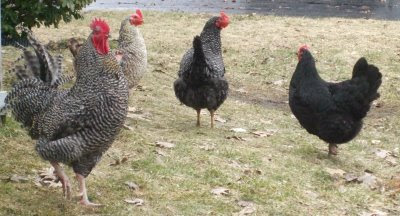In the meantime, the chickens are loving the opportunity to get out of the barn and scratch up what they can. Before we moved to a farm, we wondered what the point was of having roosters; apart from fertilizing chicken eggs, and waking everybody up at the crack of dawn with their crowing, roosters didn't seem to have much practical purpose.
How wrong we were! For starters, roosters provide order to the flock. When out foraging on the property in groups, it's usually the rooster who is most on the lookout and giving leadership to the hens accompanying him. When he uncovers a particularly prime piece of forage material, he doesn't gobble it all up. Rather, he bobs his head up and down, pointing at it, making a particular kind of deep-throated clucking noise. The hens pick up on this signal, and come running to devour whatever he's found. We've also watched roosters round up groups of hens and drive them into shelter when a fast-moving afternoon thundershower has approached.
Roosters also provide all kinds of entertainment --- especially when you have more than one. Ever wonder where the term, "Pecking Order," comes from? Just spend a day or two watching the chickens interact. There's a definite hierarchy in the chicken house, and it's loads of fun to watch. Our current Alpha Rooster is a big Rhode Island Red; he's easily the largest of the flock, and he carries himself in a way that flaunts that size. The other roosters tread lightly around him, and give him a wide berth, especially near the feeders.
But just because a particular rooster is lower on the totem pole doesn't mean he's out of luck. He just gets a smaller posse (or harem) of hens! It's the whole "posse" thing that I've found most amusing about roosters. A lower-ranking rooster will often take a small group of hens and move to either a different outbuilding or a remote corner of the chicken house. That unit will stick together, particularly when they roost at night. (Yes, the chickens really do come home to roost. Nightly.) There is one group, in particular, that Mrs Yeoman Farmer would like me to move from a corner of the barn to the main chicken area --- but every time I try to transplant them, they're back in their corner the next day.
Anyhow, these "posses" also tend to stick together when they go out to forage in the daytime. The way they carry themselves, and cluck, and signal to each other is fascinating. When we humans come too close, the rooster tends to pull himself into a "high alert" stance, and interpose himself between us and his hens. He'll then begin a more urgent clucking, which sends the hens scurrying to a new place. Once they've gone, he will then follow.
This Barred Rock rooster may rank low in the pecking order, but that's not stopping him from being a leader to the group he is in charge of:
 And maybe that can be an inspiration to us all.
And maybe that can be an inspiration to us all.
No comments:
Post a Comment